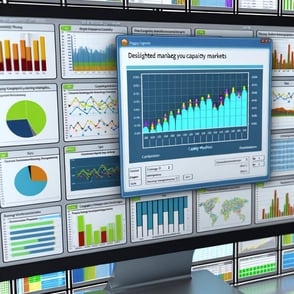Intraday Auction Market
The intraday auction market allows scheduled electricity trades during the day, enabling participants to adjust supply and demand for grid stability in response to short-term fluctuations.
What is the Intraday Auction Market?
The intraday auction market is a platform where electricity is traded through scheduled auctions at specific times during the day, in contrast to the continuous trading of the intraday continuous market. This structured approach allows participants to make planned adjustments to their electricity supply in response to short-term fluctuations, contributing to grid stability and the integration of variable renewable energy sources.
The Purpose of the Intraday Auction Market
The main purpose of the intraday auction market is to offer a structured platform where participants can make strategic adjustments to their positions within the same day, unlike the Day-Ahead Market, where trading occurs one day before delivery. These scheduled auctions enable participants to react to unexpected changes in electricity demand or generation, such as those caused by weather fluctuations impacting renewable energy production.
Various market players, including traders, utilities, industrial consumers, and large producers, must continuously balance their electricity production and consumption. Unlike futures markets that focus on long-term strategies, the intraday auction market addresses immediate needs. For example, a wind farm generating more electricity than expected can sell the excess during an auction, aligning supply with real-time demand. This market is crucial for managing last-minute imbalances and enhancing the reliability of the electricity grid.
Why Both Continuous and Auction Intraday Markets Exist
Having both continuous and auction intraday markets offers participants greater flexibility and a range of options to manage their electricity supply and demand. The continuous market allows for real-time, immediate adjustments, making it possible to respond instantly to unforeseen changes in production or consumption. This is particularly beneficial for participants who need to make quick decisions based on real-time data. On the other hand, the auction market provides structured opportunities at specific times, enabling participants to plan their trades in advance and strategically bid for electricity. This can lead to more stable and predictable pricing, as the market-clearing price is determined by aggregating supply and demand at set intervals. By offering both types of markets, the electricity system can accommodate a wide range of trading strategies and time frames, enhancing overall market efficiency and reliability.
How the Intraday Auction Market Operates
The intraday auction market functions through scheduled auctions conducted by power exchanges like Etpa. The market opens at set times each day, enabling trading in defined time blocks. These auctions are held multiple times a day, allowing for contracts in hourly, 30-minute, and 15-minute increments. Participants submit buy and sell orders before each auction, specifying the volume of electricity and prices they are willing to accept. The trading platform aggregates these orders to determine a market-clearing price, matching supply with demand.
Cross-border initiatives, such as the Cross-Border Intraday (XBID) market, have expanded trading beyond national borders, allowing participants to trade electricity across multiple European countries: Austria, Belgium, Denmark, Estonia, Finland, France, Germany, Latvia, Lithuania, the Netherlands, Norway, Portugal, Spain, and Sweden. This broader participation enhances market efficiency and contributes to grid stability.
Price Formation in the Intraday Auction Market
Prices in the intraday auction market are determined through a uniform pricing mechanism, where the market-clearing price is set at the intersection of aggregated supply and demand curves. This mechanism results in a single price for all transactions within each auction period, reflecting real-time market conditions. Consequently, prices can vary between different auction periods throughout the day.
.png?width=2151&height=1101&name=output%20(1).png)
The Impact of the Intraday Auction Market
The intraday auction market plays a vital role in maintaining the stability and efficiency of the electricity system. The market's structured approach helps prevent imbalances that could destabilize the grid. By providing scheduled supply and demand signals, the market enhances grid efficiency and manages price volatility, allowing participants to respond to real-time price movements.
Moreover, the market supports the integration of renewable energy sources, which are often variable and unpredictable. By facilitating the sale of excess generation or the purchase of shortfalls in a structured manner, the intraday auction market helps balance the grid despite fluctuations in renewable energy production. This balancing act is crucial for maintaining grid stability and promoting the growth of renewables as their share in the energy mix increases.
Conclusion
The intraday auction market is an essential platform for structured electricity trading. It plays a critical role in maintaining grid stability and efficiency, especially in the face of unpredictable fluctuations in generation and consumption. By supporting the integration of variable renewable energy sources, the intraday auction market contributes to the transition toward a more sustainable energy system. Its role in providing scheduled responses to supply and demand changes ensures reliability and efficiency.
As the energy landscape continues to evolve, the significance of the intraday auction market will increase, making it an indispensable component of modern electricity markets.
Glossary
- Bid: An offer to buy electricity at a specific price.
- Offer: An offer to sell electricity at a specific price.
- Day-Ahead Market: A market where electricity trading occurs one day before delivery, allowing participants to plan their electricity needs and production in advance.
- Auction Trading: A trading process where participants submit bids and offers before a scheduled auction, with transactions occurring at the market-clearing price determined by the auction.
- Grid Stability: The ability of the electricity grid to maintain a consistent and reliable supply of electricity, despite fluctuations in generation and consumption.
- Renewable Energy Sources: Energy sources that are naturally replenished, such as wind, solar, hydro, and biomass.
- Cross-Border Intraday (XBID) Market: An initiative that allows intraday trading of electricity across multiple European countries, enhancing market efficiency and responsiveness.
- Uniform Pricing Mechanism: A pricing method where all transactions within an auction period are priced at the market-clearing price.
- Order Matching: The process of pairing buy and sell orders on a trading platform based on price and time.
- Price Volatility: The degree of variation in electricity prices over time, often influenced by supply and demand changes.
- Grid Efficiency: The effectiveness with which the electricity grid manages and distributes electricity to meet demand while minimizing waste and losses.
- Market Depth: The volume of bids and offers available at different price levels in the market.
- Hourly Contracts: Contracts specifying the delivery of electricity for each hour within the same day.
- 30-Minute Contracts: Contracts specifying the delivery of electricity in 30-minute intervals within the same day.
- 15-Minute Contracts: Contracts specifying the delivery of electricity in 15-minute intervals within the same day.
.png?width=200&height=80&name=etpa-logo-color%20(1).png)











.png)
.png)
-1.png?width=250&height=100&name=etpa-logo-color%20(1)-1.png)